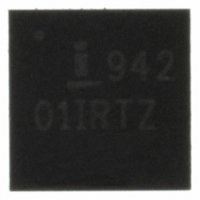ISL94201IRZ Intersil, ISL94201IRZ Datasheet - Page 13

ISL94201IRZ
Manufacturer Part Number
ISL94201IRZ
Description
IC MULTI LI-ION AFE 24-QFN
Manufacturer
Intersil
Datasheet
1.ISL94201IRZ.pdf
(19 pages)
Specifications of ISL94201IRZ
Function
Over/Under Voltage Protection
Battery Type
Lithium-Ion (Li-Ion)
Voltage - Supply
5 V ~ 10 V
Operating Temperature
-40°C ~ 85°C
Mounting Type
Surface Mount
Package / Case
24-VFQFN Exposed Pad
Lead Free Status / RoHS Status
Lead free / RoHS Compliant
Available stocks
Company
Part Number
Manufacturer
Quantity
Price
Company:
Part Number:
ISL94201IRZ
Manufacturer:
Intersil
Quantity:
25
Part Number:
ISL94201IRZ
Manufacturer:
INTERSIL
Quantity:
20 000
I
AO
SCL
SDA
2
AO
C
FIGURE 4. EXTERNAL TEMPERATURE MONITORING
FIGURE 5. ANALOG OUTPUT MONITORING DIAGRAM
TEMP FAIL
INDICATOR
XOT
DECODE
MUX
AO3:AO0
I
2
C
2
EXT TEMP
AND CONTROL
AO3:AO0
DECODE
ATMPOFF
TMP3ON
REGS
MUX
MUX
I
2
OSC
C
VSS (ON)
DELAY
EXTERNAL
MONITOR
1ms
TEMP
13
4ms
508ms
EXT TEMP.
LEVEL
LEVEL
LEVEL
LEVEL
SHIFT
SHIFT
SHIFT
SHIFT
TEMP
INT
TEMPI
VSS
VSS
RGO
TEMP3V
TEMPI
VC7/VCC
VCELL6
VCELL2
VCELL1
R
X
TO
µ
ISL94201
User Flags
The ISL94201contains four flags in the register area that the
microcontroller can use for general purpose indicators.
These bits are designated UFLG3, UFLG2, UFLG1, and
UFLG0. The microcontroller can set or reset these bits by
writing into the appropriate register.
The user flag bits are battery backed up, so the contents
remain even after exiting a sleep mode. However, if the
microcontroller sets the POR bit to force a power on reset, all
of the user flags will also be reset. In addition, if the voltage
on cell1 ever drops below the POR voltage, the contents of
the user flags (as well as all other register values) could be
lost.
Serial Interface
INTERFACE CONVENTIONS
The device supports a bidirectional bus oriented protocol.
The protocol defines any device that sends data onto the
bus as a transmitter, and the receiving device as the
receiver. The device controlling the transfer is called the
master and the device being controlled is called the slave.
The master always initiates data transfers, and provides the
clock for both transmit and receive operations. Therefore,
the ISL94201devices operate as slaves in all applications.
When sending or receiving data, the convention is the most
significant bit (MSB) is sent first. So, the first address bit sent
is Bit 7.
CLOCK AND DATA
Data states on the SDA line can change only while SCL is
LOW. SDA state changes during SCL HIGH are reserved for
indicating start and stop conditions. See Figure 6.
START CONDITION
All commands are preceded by the start condition, which is a
HIGH to LOW transition of SDA when SCL is HIGH. The
device continuously monitors the SDA and SCL lines for the
start condition and will not respond to any command until
this condition has been met. See Figure 7.
STOP CONDITION
All communications must be terminated by a stop condition,
which is a LOW to HIGH transition of SDA when SCL is
HIGH. The stop condition is also used to place the device
into the Standby power mode after a read sequence. A stop
condition is only issued after the transmitting device has
released the bus. See Figure 7.
ACKNOWLEDGE
Acknowledge is a software convention used to indicate
successful data transfer. The transmitting device, either
master or slave, releases the bus after transmitting eight
bits. During the ninth clock cycle, the receiver pulls the SDA
line LOW to acknowledge that it received the eight bits of
data. See Figure 8.
July 3, 2008
FN6719.0











